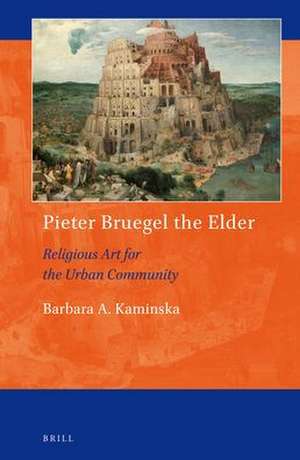Pieter Bruegel the Elder: Religious Art for the Urban Community: Art and Material Culture in Medieval and Renaissance Europe, cartea 15
Autor Barbara A. Kaminskaen Limba Engleză Hardback – 10 iul 2019
Din seria Art and Material Culture in Medieval and Renaissance Europe
- 18%
 Preț: 1022.23 lei
Preț: 1022.23 lei - 18%
 Preț: 760.66 lei
Preț: 760.66 lei - 18%
 Preț: 755.94 lei
Preț: 755.94 lei - 18%
 Preț: 707.87 lei
Preț: 707.87 lei - 18%
 Preț: 903.85 lei
Preț: 903.85 lei - 18%
 Preț: 684.83 lei
Preț: 684.83 lei - 18%
 Preț: 766.37 lei
Preț: 766.37 lei - 18%
 Preț: 953.67 lei
Preț: 953.67 lei - 18%
 Preț: 945.21 lei
Preț: 945.21 lei - 18%
 Preț: 882.30 lei
Preț: 882.30 lei - 18%
 Preț: 702.37 lei
Preț: 702.37 lei - 18%
 Preț: 731.49 lei
Preț: 731.49 lei - 18%
 Preț: 778.52 lei
Preț: 778.52 lei - 18%
 Preț: 808.19 lei
Preț: 808.19 lei - 18%
 Preț: 635.78 lei
Preț: 635.78 lei - 18%
 Preț: 1084.46 lei
Preț: 1084.46 lei - 18%
 Preț: 951.91 lei
Preț: 951.91 lei - 18%
 Preț: 769.14 lei
Preț: 769.14 lei - 18%
 Preț: 986.97 lei
Preț: 986.97 lei - 18%
 Preț: 615.62 lei
Preț: 615.62 lei
Preț: 671.15 lei
Preț vechi: 818.48 lei
-18% Nou
Puncte Express: 1007
Preț estimativ în valută:
128.44€ • 133.60$ • 106.04£
128.44€ • 133.60$ • 106.04£
Carte indisponibilă temporar
Doresc să fiu notificat când acest titlu va fi disponibil:
Se trimite...
Preluare comenzi: 021 569.72.76
Specificații
ISBN-13: 9789004400399
ISBN-10: 9004400397
Dimensiuni: 155 x 235 mm
Greutate: 0.54 kg
Editura: Brill
Colecția Brill
Seria Art and Material Culture in Medieval and Renaissance Europe
ISBN-10: 9004400397
Dimensiuni: 155 x 235 mm
Greutate: 0.54 kg
Editura: Brill
Colecția Brill
Seria Art and Material Culture in Medieval and Renaissance Europe
Cuprins
Contents
Acknowledgments
List of Figures
Introduction
1 Negotiating Entrepreneurship in Early Modern Antwerp: Pieter Bruegel’s The Tower of Babel
1 For “an Idel and Foolish Ostentation of Money”? The Tower of Babeland the Ambiguities of Progress
2 Framing the Tower of Babel: Space, Conversation, People
3 Monopolies, Self-Interest, and the Common Good
4 Antwerp as an International “Community of Commerce” in Philip’s 1549 Joyous Entry
2 Conversion on Display: Imperial Politics, Religious Transformation, and Socioeconomic Stability in Antwerp
1 Images of the Conversion of Saint Paul in Probate Inventories and the Location of Works of Art
2 “Alzo tot onzer kennesse ghecommen es”: Habsburg Legislation and the Culture of External Display in Antwerp
3 Defining Conversion in the Sixteenth-Century Low Countries
4 Between Light and Darkness: Bruegel’s The Conversion of Saint Paul and Dutch Vernacular Theatre
5 Toward a New Model of Religiosity
3 “In Their Houses”: Domestic Space and Religious Practices in Mid-Sixteenth-Century Antwerp
1 “Permissible even for sailors”? Lay Reading of the Bible and Spanish Legislation in Antwerp
2 Theological Approaches to Religious Imagery in Private Households
3 In “zyne huysen”: The Procession to Calvary, Ommegangen, and the Relocation of Religious Practices
4 “Outside in the Woods”: The Sermon of Saint John the Baptistand Hedge-Preaching in Antwerp
1 Picturing Conversations in Bruegel’s Sermon of Saint John the Baptist
5 “If You Are without a Sin”: Religious and Artistic Discourse in Christ and the Woman Taken in Adultery
1 Truth and Penitence in Christ and the Woman Taken in Adultery
2 Adultery, Idolatry, and Rhetorical Strategies of Bruegel’s Grisaille
6 Choosing “the Best Part”: Christian Death and Life in Bruegel’s The Death of the Virgin
1 “Sweet Sleep” and the Transition from Vita Activa to Vita Contemplativa in Bruegel’s Grisaille
2 Artistry and Theological Truth in the Images of the Death of the Virgin
Epilogue
Bibliography
Index
Acknowledgments
List of Figures
Introduction
1 Negotiating Entrepreneurship in Early Modern Antwerp: Pieter Bruegel’s The Tower of Babel
1 For “an Idel and Foolish Ostentation of Money”? The Tower of Babeland the Ambiguities of Progress
2 Framing the Tower of Babel: Space, Conversation, People
3 Monopolies, Self-Interest, and the Common Good
4 Antwerp as an International “Community of Commerce” in Philip’s 1549 Joyous Entry
2 Conversion on Display: Imperial Politics, Religious Transformation, and Socioeconomic Stability in Antwerp
1 Images of the Conversion of Saint Paul in Probate Inventories and the Location of Works of Art
2 “Alzo tot onzer kennesse ghecommen es”: Habsburg Legislation and the Culture of External Display in Antwerp
3 Defining Conversion in the Sixteenth-Century Low Countries
4 Between Light and Darkness: Bruegel’s The Conversion of Saint Paul and Dutch Vernacular Theatre
5 Toward a New Model of Religiosity
3 “In Their Houses”: Domestic Space and Religious Practices in Mid-Sixteenth-Century Antwerp
1 “Permissible even for sailors”? Lay Reading of the Bible and Spanish Legislation in Antwerp
2 Theological Approaches to Religious Imagery in Private Households
3 In “zyne huysen”: The Procession to Calvary, Ommegangen, and the Relocation of Religious Practices
4 “Outside in the Woods”: The Sermon of Saint John the Baptistand Hedge-Preaching in Antwerp
1 Picturing Conversations in Bruegel’s Sermon of Saint John the Baptist
5 “If You Are without a Sin”: Religious and Artistic Discourse in Christ and the Woman Taken in Adultery
1 Truth and Penitence in Christ and the Woman Taken in Adultery
2 Adultery, Idolatry, and Rhetorical Strategies of Bruegel’s Grisaille
6 Choosing “the Best Part”: Christian Death and Life in Bruegel’s The Death of the Virgin
1 “Sweet Sleep” and the Transition from Vita Activa to Vita Contemplativa in Bruegel’s Grisaille
2 Artistry and Theological Truth in the Images of the Death of the Virgin
Epilogue
Bibliography
Index
Notă biografică
Barbara A. Kaminska, Ph.D. (University of California, Santa Barbara, 2014) is an Assistant Professor of Art History at Sam Houston State University in Huntsville, TX. Her publications include essays in “Renaissance and Reformation” and “Journal of Historians of Netherlandish Art.”
